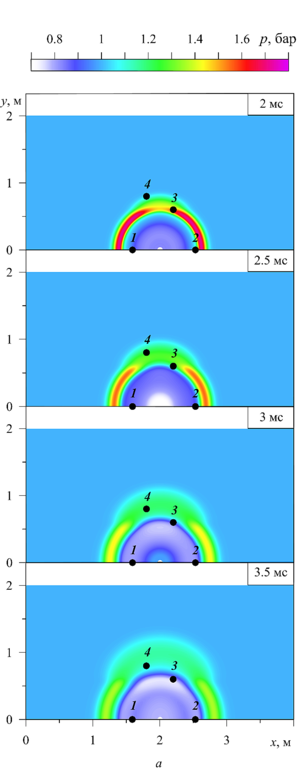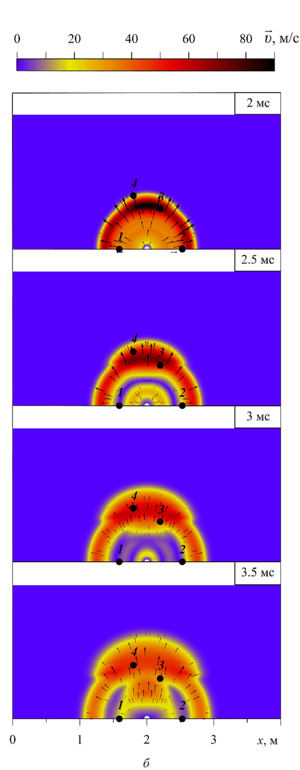

Numerical simulation of the spherical shock pulse propagation in aqueous foam with volumetric liquid fraction of 0.0083 has been carried out in accordance with the published experimental data on the explosion of HE in aqueous foam. The assumption is used that the foam structure is destroyed by the shock wave, which leads to the transformation of the foam into a monodisperse gas-droplet mixture. The system of equations for the two-phase gas-droplet model of aqueous foam includes the laws of conservation of mass, momentum, energy for each phase and the equation for the dynamics of the volumetric liquid fraction in a single-pressure, two-velocity, two-temperature approximations in a three-dimensional formulation and takes into account the forces of the Schiller-Naumann interfacial drag, the Ranz-Marshall interphase contact heat exchange and the effect of foam syneresis on the initial distribution of its volumetric liquid fraction. Realistic equations of state in the form of Peng-Robinson and Mie-Gruneisen are used to describe the thermodynamic properties of air and water that make up a gas-droplet mixture. Numerical modeling of the processes under consideration was carried out in the open software of computational fluid dynamics OpenFOAM using the finite volume method based on the iterative two-step PIMPLE algorithm. The analysis of the effect of foam syneresis on the dynamics of shock pulse in aqueous foam is given. It was found that the uneven distribution of the liquid fraction in the foam, caused by its sedimentation under the gravity, leads to the increase in the shock pulse velocity in upper layers of the foam. In comparative analysis of numerical solutions and experimental data at sensor locations, the importance of taking into account syneresis phenomena in modeling the dynamics of shock wave in aqueous foam is shown. The reliability of calculations obtained by the proposed model is confirmed by their agreement with experimental data.
spherical explosion,
shock wave,
aqueous foam,
OpenFOAM package,
numerical modeling
Purpose. Study of the aqueous foam syneresis influence on the dynamics of the spherical shock wave propagation in the foam medium.
Methodology. Using the assumption about the destruction of the foam structure by a shock pulse with the formation of a suspension of equal diameter microdroplets in the gas behind the front of a strong shock wave allows one to use a gas-droplet mixture model for describing aqueous foam. The system of model equations for a gas-droplet medium includes the equations of continuity, momentum, energy for each phase and the equation of the volumetric liquid fraction dynamics in accordance with the one-pressure, two-velocity, two-temperature approximations in a two-dimensional axisymmetric formulation. The interfacial drag forces are described by the Schiller-Naumann model, the interfacial contact heat transfer is determined in accordance with the Ranz-Marshall model. The effect of foam syneresis on its initial volumetric liquid fraction is determined by the parameter introduced into the expression for the interfacial drag force. The Peng-Robinson equation of state and the wide-range equation of state for water in the Mie-Gruneisen form with an elastic potential of the Born-Mayer type are used to describe the properties of gas and water as components of aqueous foam. The proposed model of a gas-droplet mixture is implemented in a solver created in the OpenFOAM open software.
The computational domain is a sphere with a radius of 2 m, in the center of which, at the initial moment of time, a pressure pulse is set to simulate an explosion. The explosion center is isolated by a sphere with a radius of 0.04 m with a rigid wall boundary condition on its surface in order to increase the stability of calculations. The discretization of the system of model equations is performed by the finite volume method. The solution method is based on a two-step computational algorithm PIMPLE.
Findings. Comparative analysis of calculations and experimental data from sensors located at different distances and heights relative to the center of the explosion is performed. The calculated dynamics of the shock wave recorded by sensors located in the same horizontal plane with the explosion point coincides with the experimental pressure oscillograms in terms of velocity, amplitude, and two-wave structure of the shock pulse. The importance of taking into account the effect of foam deposition in simulating the shock wave propagation in a foam medium is demonstrated by calculations from sensors located in the foam upper layers: the syneresis process increases the speed of the shock pulse, which is most pronounced in the data of sensor located above the others.
The numerical study of the spherical shock wave propagation in aqueous foam was carried out for the conditions of experiments on the spherical explosion of HE in the foam medium with initial volumetric liquid fraction of 0.0083.
Spherical shock-wave pulse dynamics in aqueous foam is shown in the form of calculated spatial distributions of pressure and vector velocity fields at different times. The process of foam syneresis is accompanied by an increase in the volumetric gas fraction in its upper layers due to the downward movement of the liquid fraction of the foam under the action of gravitational forces. The uneven distribution of the liquid fraction in height affects the speed of the shock wave propagation in the foam medium: with increasing height, the foam becomes less dense, which increases the speed of the wave in the vertical direction.
The agreement between the calculated and experimental data confirms the reliability of the obtained numerical solutions.
Value. The evolution of spherical explosion in aqueous foam, modeled in accordance with published experimental data, is numerically investigated. The spatial mathematical model used to describe the shock wave dynamics in aqueous foam takes into account the forces of interfacial interaction, contact heat transfer, and the effect of aqueous foam settling by gravity on the initial distribution of the volumetric liquid fraction in the foam medium. The numerical implementation of the proposed model was carried out in the open software OpenFOAM. The analysis of the shock wave dynamics in aqueous foam is carried out. It is shown that a decrease in the volumetric liquid fraction in the upper layers of the foam during its syneresis is accompanied by a significant increase in the velocity of the shock pulse in the vertical direction. The reliability of the calculations is confirmed by comparing the experimental and numerical pressure oscillograms at the locations of the sensors.



